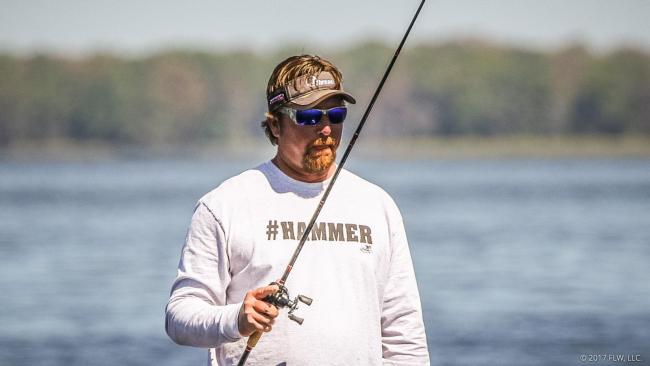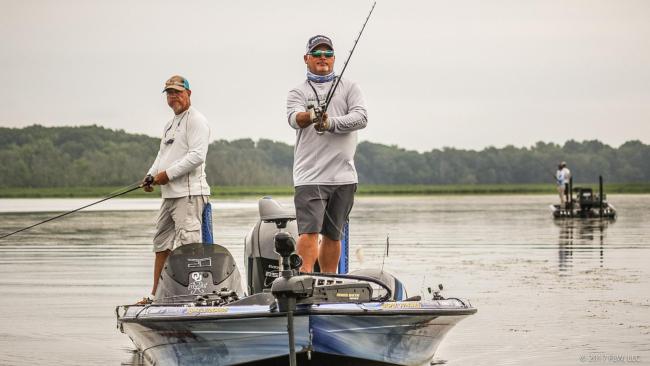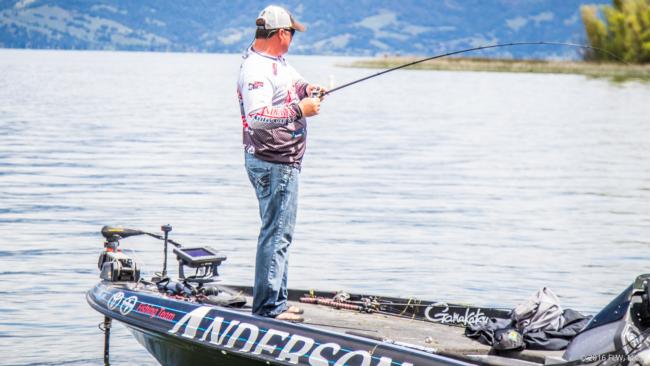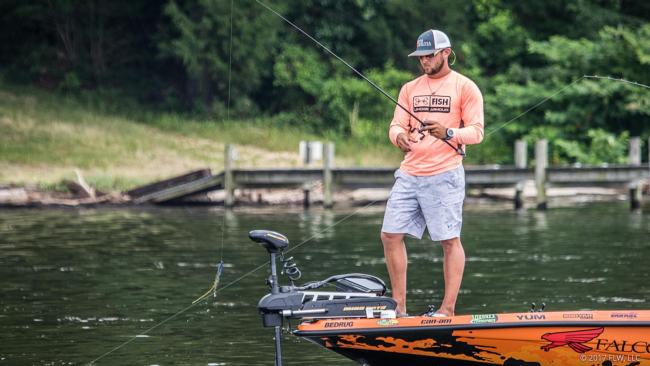Cup Pre-Practice Reports
What pros learned in their early trips to Lake Murray
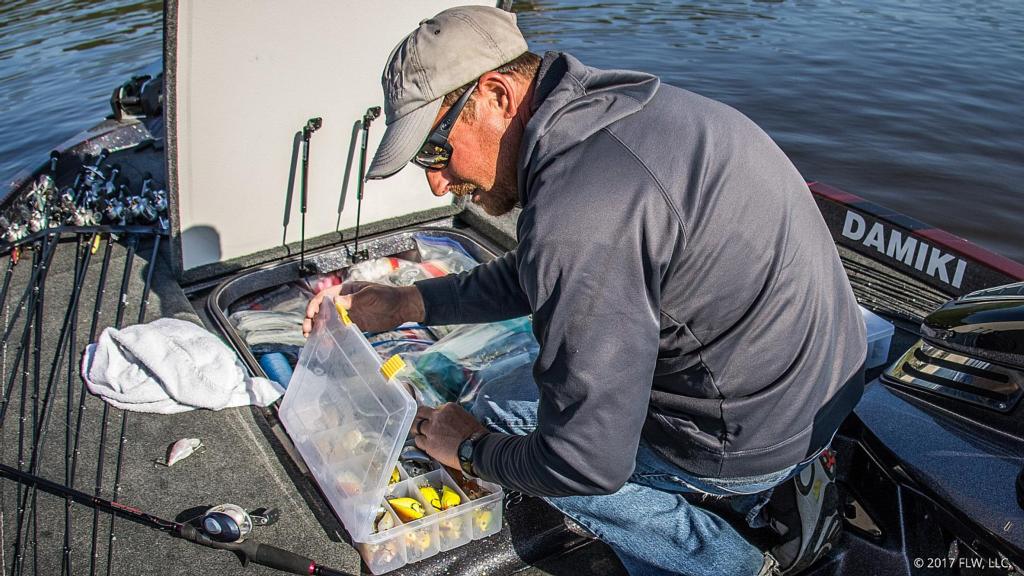
Lake Murray is hardly an unknown among FLW pros. The site of this year’s Forrest Wood Cup near Columbia, S.C., also hosted the championship in 2008 and 2014. Nevertheless, several Cup qualifiers made pre-practice scouting trips to the lake prior to it going off limits on Monday and found it pretty much aligning with what you’d expect for this time of year – stifling heat, high water temperatures and tough, tough fishing. Then again, pros are rarely willing to divulge too much information, and they usually report that fishing is “tough” before any major event.
Formed by the Saluda Dam, which impounds its namesake river, the 50,000-acre Lake Murray measures 41 miles long by 14 miles wide and boasts a maximum depth of 200 feet. Summer events typically find anglers leveraging a mix of offshore and shallow-water patterns, and the pros I spoke with predicted the same for this year’s event.
Here’s a brief report from several.
JT Kenney
The 16-year FLW Tour pro from Palm Bay, Fla., spent four days on Lake Murray before cutoff and reports the water level a little below normal summer pool of 360 feet. The official report as of Wednesday, July 26 shows the water level at about 357.
Kenney says it looked like there might have been an algae bloom throughout parts of the lake. Predictably, the water was clearer down by the dam, with the mid-lake region sporting a greenish tint that Kenney referred to as “good fishing water.”
He didn’t locate much of what he’d consider fishable grass, but Kenney did note a band of stringy pondweed growing from about 7 feet out to 13 to 14. He also saw schooling activity, compliments of a non-native forage fish known for whipping up brief moments of tremendous opportunity.
“There’s a lot of blueback herring in the lake, and you can get right really easily on those if you find a school of fish running them to the top,” Kenny says. “I had a day where I had a big bag — probably 14 to 15 pounds in 12 casts – when that happened. But if that doesn’t happen, you’re struggling to catch 10 pounds.”
While he recognizes the blueback potential, Kenney says he wouldn’t even consider staking his tournament solely on this open-water game of cat-and-mouse. He spent a lot of time scoping out attractive shallow cover to balance the pelagic stuff. For the schoolers, he’ll watch and listen for the telltale signs.
“Those fish that chase the blueback herring are fat, healthy 3 1/2-pound fish that you can definitely win with,” Kenney says. “But they don’t come up on the same spot, on the same schedule all the time. I think you’re going to have to run spot-to-spot and keep your eyes open for little baitfish flopping on the surface.
“It’s probably going to be your typical ‘summertime in the Southeast’ tournament. I’m sure that one day there’s going to be a 17-pound bag, but 13 1/2 a day over three days will probably win it. It’s just a tough time of the year because of the heat.”
Chris McCall
The Texas pro had planned to spend four days on Murray, but pulled the plug after two and a half. Hot, still conditions yielded only four keeper bites: two on the bank, two on docks. Noting water temperatures in the upper 80s to low 90s, McCall also found plenty of pondweed, just none of the vegetation he would have preferred.
“The last two times [the Cup was on Murray in 2008 and 2014], the water willow has been a big player, but I saw no grass [water willow] that had more than 6 inches of water on it in a lot of the areas where they caught them last time,” McCall says.
He also reports seeing some beds of grass that he believes were milfoil or something similar, though it wasn’t formed up in such a way that he thinks it’ll be a player.
McCall says he marked more bait upriver than down the lake. He’s reasonably certain he was looking at shad, but he’s not overlooking the blueback influence.
“Obviously, because of the bluebacks, those fish suspend a lot in that lake,” he says.
Even though his pre-practice was less than stellar, McCall says it was time well spent. A big chunk of such efforts involves elimination, and he feels he definitely did a lot of that.
Roy Hawk
The Western standout from Lake Havasu City, Ariz., spent a week on Lake Murray and left with memories of voluminous bait schools. Hawk says he marked big balls of shad inside the creek arms and on the main lake, while several instances of schooling activity caught his attention from outside his casting range.
“I couldn’t tell if it was blueback herring or shad, but the bass were blowing up on it,” he says. “There were also a lot of little bluegills on the shoreline.”
While doing more looking than fishing, Hawk says he averaged two keepers a day. Reaction baits and slow presentations produced fish, some of which came from shallow vegetation.
“There’s a lot of bank grass, and there’s some that has good water on it – like 3 to 4 feet deep,” Hawk says. “A lot of times, if you have 2 feet on that grass, that’s good enough. There’s also some low-lying aquatic vegetation that blankets the bottom. I didn’t catch anything out of that, but I think that helps keep fish coming up shallow.”
Bryan Thrift
The 2017 FLW Tour Angler of the Year says the overall water quality reminded him of his 2014 Cup experience: high clarity on the lower end, with visibility levels ranging from about 8 to 30 inches as he progressed toward the river. Thrift also found plenty of pondweed growing out to 15 feet, with matting in the shallower stretches. This stringy, clingy vegetation, which Thrift likened to Velcro, probably has some attraction for bass, but efficient presentations are mostly limited to surface baits.
The North Carolina pro says he didn’t mark a lot of bait, but he saw some breaking action that could have been bluebacks or shad. Bream were abundant, and considering the bluegill spawn can stretch into August, Thrift says he’ll keep watch for this pattern.
Overall, Thrift says he’s expecting this year’s Cup to play out much like the 2014 event. During that tournament, in which Thrift placed seventh, anglers caught fish offshore, as well as in the river.
“I think the shallow or deep bite could be dominant. I think it would be best to have a mix, but it could be won without having both,” Thrift says. “I think you’ll need to fish with an open mind. A guy could win this tournament with five bites a day – even five bites one day and four the next. That’s why I like summertime fishing; one bite could make all the difference. I really think that’s what it’s going to come down to.”
Zack Birge
The Oklahoma pro says he found Murray’s warm summer water considerably clearer than he was expecting, with clarities ranging from a foot in some areas to 10 feet in others. He located several types of grass, including water willow and large fields of matted pondweed.
“I had never been to Lake Murray before, but it reminds me of Lake Ouachita, and I think it’s going to fish very similar,” the third-year Tour pro says. “There’s a main river running in, and there are a couple of arms that run way back in there with good creeks. Then you have the main lake that will be a factor with schooling fish and deep brush pile fish.
“You can pick your poison and do what you’re confident in. I’m going to do my best to make the river thing work and then try to upgrade later in the day on the make-lake stuff.”
Birge says he actually fished (versus just scouting and looking) for several hours during his week of pre-practice and caught enough quality fish – mostly on reaction baits – to have an optimistic Cup outlook. He made a mental note of the blueback deal, but he’s not going to base his game plan on blueback-eating bass.
“There are a lot of schooling fish, and you can either catch them good or it can bite you in the butt,” Birge says. “If I can figure out the river fish, I’m more confident with that, rather than waiting and crossing my fingers for schooling fish.
“In practice, I saw several good fish following my bait. These fish revealed themselves in areas that maybe I can go back and make them productive during the tournament.”
